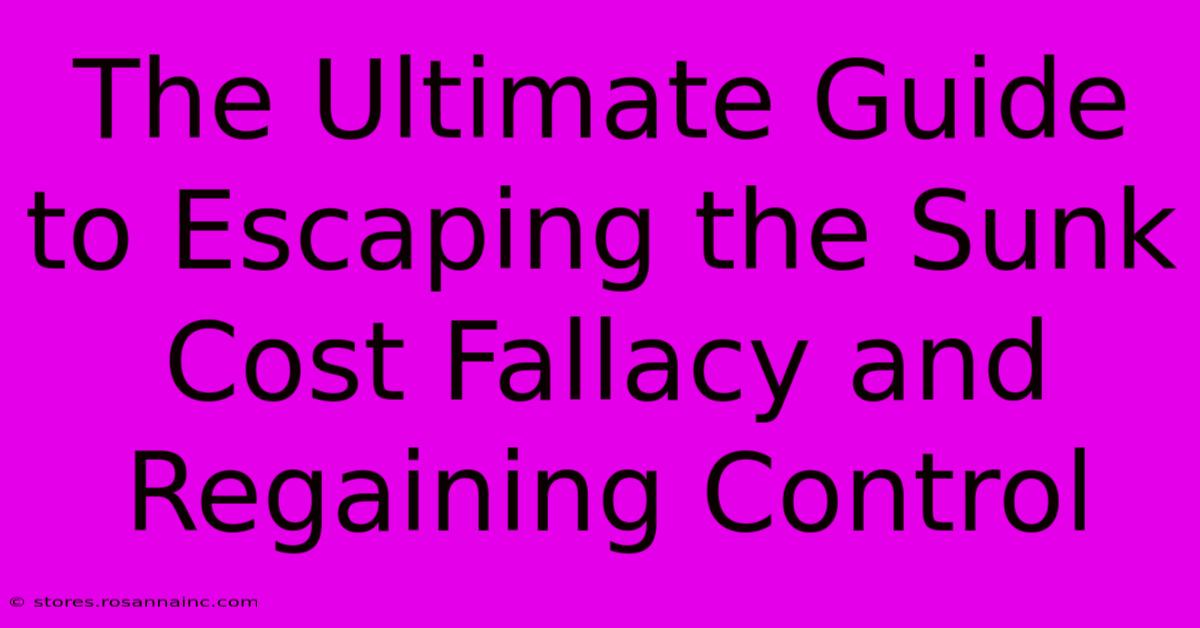The Ultimate Guide To Escaping The Sunk Cost Fallacy And Regaining Control

Table of Contents
The Ultimate Guide to Escaping the Sunk Cost Fallacy and Regaining Control
We've all been there. Stuck in a situation, pouring more time, money, or energy into something that's clearly not working, all because we've already invested so much. This is the sunk cost fallacy, a powerful cognitive bias that traps us in unproductive endeavors and prevents us from making rational decisions. This guide will help you understand the sunk cost fallacy, identify it in your life, and finally break free.
Understanding the Sunk Cost Fallacy
The sunk cost fallacy is the tendency to continue investing in something – be it a project, relationship, or purchase – simply because you've already invested resources into it, regardless of whether continuing is beneficial. These "sunk costs" are irretrievable; past investments shouldn't dictate future decisions. Time, money, and effort are all examples of sunk costs.
Think of it this way: you've already paid for a movie ticket, but the movie is terrible. Do you stay and watch it, justifying the expense? That's the sunk cost fallacy in action. The money is gone; staying doesn't magically make the movie better. The rational decision is to leave and do something more enjoyable.
Why We Fall Prey to the Sunk Cost Fallacy
Our brains are wired to avoid losses more strongly than we seek gains (loss aversion). Quitting something we've invested in feels like admitting defeat, a loss we're hardwired to avoid. This aversion to loss can override logical reasoning, leading us to persist even when the odds are stacked against us.
Other factors contributing to the fallacy include:
- Confirmation bias: We tend to seek information confirming our existing beliefs, reinforcing our commitment to the failing venture.
- Commitment escalation: The more we invest, the more committed we become, making it harder to walk away.
- Ego: Quitting can feel like admitting failure, damaging our self-esteem.
Identifying the Sunk Cost Fallacy in Your Life
The sunk cost fallacy manifests in various ways. Are you:
- Staying in a dead-end job? You've spent years climbing the ladder, but opportunities are limited. Is it time for a change?
- Persisting in a failing relationship? You've invested years and emotions, but the relationship isn't fulfilling. Holding on is causing more pain than letting go.
- Continuing a hobby you don't enjoy? You've invested significant money and time, but you dread engaging with it.
- Spending excessive time on a project with little return? You're pouring hours into something that's unlikely to succeed.
Escaping the Trap: Practical Strategies for Regaining Control
Breaking free from the sunk cost fallacy requires conscious effort and a shift in mindset. Here's how:
1. Acknowledge and Accept Past Investments
The first step is acknowledging that sunk costs are in the past. You cannot recover them. Dwelling on them only hinders your ability to make rational choices about the future.
2. Focus on Future Value and Potential Outcomes
Instead of focusing on what you've already invested, concentrate on the potential return on future investments. Will continuing to invest in this venture yield positive results? If not, it's time to move on.
3. Separate Emotions from Logic
The sunk cost fallacy is largely driven by emotion. Learn to separate your feelings from the facts. Ask yourself: "If I were starting this project/relationship/endeavor today, would I invest in it?" Your answer will often be the rational course of action.
4. Set Clear Exit Strategies
Before embarking on any significant project or commitment, establish clear criteria for when to quit. Defining these boundaries in advance helps prevent emotional attachment from overriding rational decision-making.
5. Seek Outside Perspectives
Sometimes, an objective outsider can provide a fresh perspective. Talk to trusted friends, family, or mentors about your situation. Their insights may help you see the situation more clearly.
6. Practice Self-Compassion
Leaving something you've invested in can feel like failure. Be kind to yourself. Recognizing and overcoming the sunk cost fallacy is a sign of strength and self-awareness, not weakness.
Regaining Control and Moving Forward
Escaping the sunk cost fallacy is about reclaiming your time, energy, and resources to pursue opportunities aligned with your goals. By understanding the fallacy, identifying it in your life, and implementing these strategies, you can break free from unproductive commitments and take control of your future. Remember, letting go of the past doesn't mean you've failed; it means you're making a rational decision for a brighter future.

Thank you for visiting our website wich cover about The Ultimate Guide To Escaping The Sunk Cost Fallacy And Regaining Control. We hope the information provided has been useful to you. Feel free to contact us if you have any questions or need further assistance. See you next time and dont miss to bookmark.
Featured Posts
-
Unlock Productivity Why A Conference Room Rental Is Key To Your Business Growth
Feb 06, 2025
-
Nail The Dip Powder Trend A Step By Step Tutorial For Beginners
Feb 06, 2025
-
Game Changer Unlock The Power Of Lightning Fast Responses
Feb 06, 2025
-
Ancient Celtic Symbols Decoded The Meaning Behind Intricate Knot Patterns
Feb 06, 2025
-
Babys Breath Care Guide Nurturing Your Delicate Delights
Feb 06, 2025
